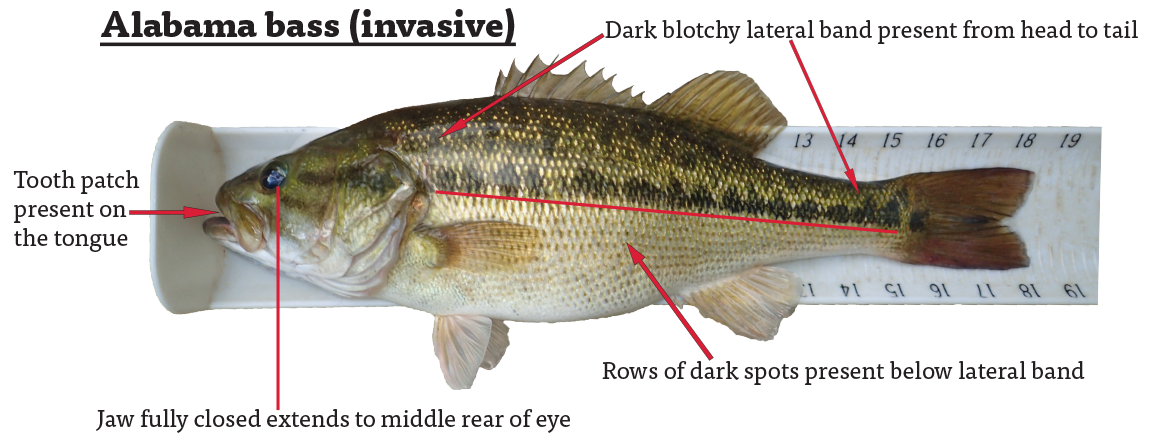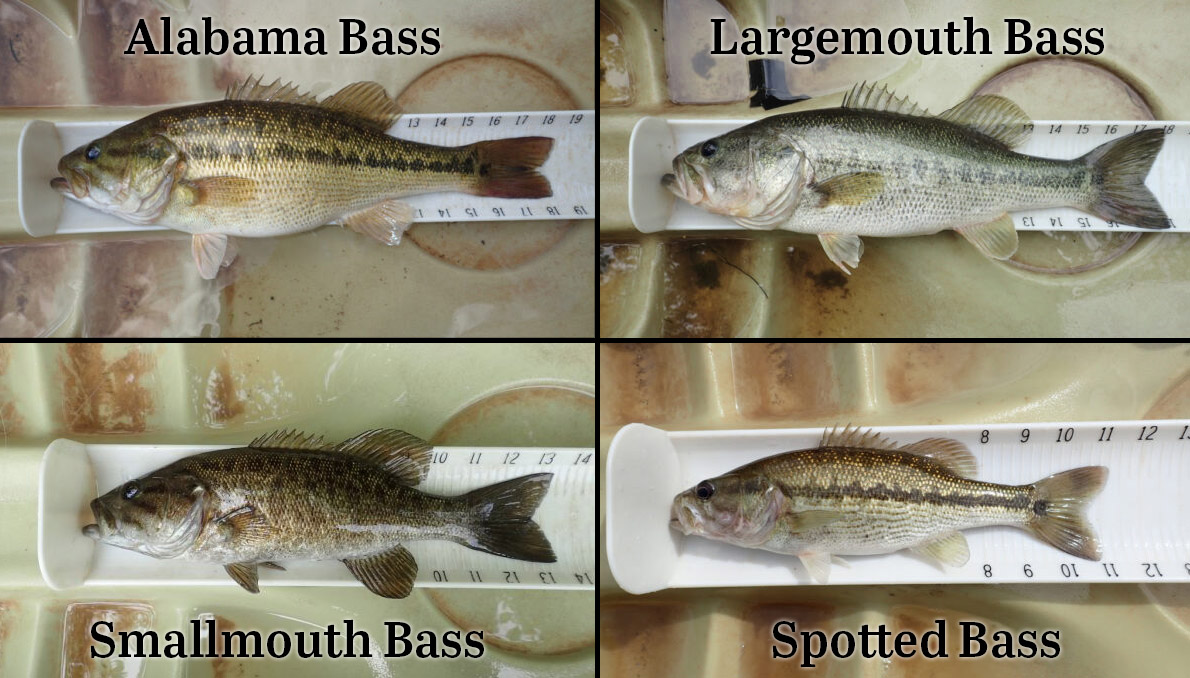Fact File
Scientific Name: Micropterus henshalli
Classification: Fish, Order Perciformes, Family Centrarchidae
Conservation Status:
- Invasive Species
- Predatory and Undesirable Species
Identifying Characteristics

- The jaw of Alabama Bass lines up with the middle rear of the eye, while Largemouth Bass jaws extend past the eye
- Alabama Bass have a dark, blotchy lateral band from head to tail, and have spots below this band
- Largemouth Bass have a more continuous lateral band
- Alabama Bass also typically have a tooth patch on their tongue, which is more uncommon in Largemouth Bass
- Alabama and Spotted Bass are differentiated by differences in lateral line scale counts or genetic analysis
Distribution:
Within Virginia, the Alabama Bass is confirmed to be present in Lake Gaston, Buggs Island Lake (Kerr Reservoir), Claytor Lake, the New River below Claytor Lake, Philpott Lake, Martinsville Reservoir, Diascund Reservoir, James River (Fall-Line area in Richmond), and the Chickahominy River.
The Department of Wildlife Resources (DWR) is conducting genetic testing to better identify the extent of Alabama Bass throughout Virginia.
What are Alabama Bass?
Alabama Bass (Micropterus henshalli) are one of approximately twelve species of black bass. They are an aggressive species that outcompetes Largemouth Bass and readily hybridizes with Smallmouth and Spotted Bass. Alabama Bass are nearly identical in appearance to Spotted Bass, and were formerly known as the Alabama subspecies of the Spotted Bass. The other former subspecies of Spotted Bass, the Kentucky Spotted Bass, is found throughout Virginia and is native to the southwest portion of the Commonwealth.
The jaw of Alabama Bass lines up with the middle rear of the eye, while Largemouth Bass jaws extend past the eye. Alabama Bass have a dark, blotchy lateral band from head to tail, and have spots below this band. Largemouth Bass have a more continuous lateral band. Alabama Bass also typically have a tooth patch on their tongue, which is rare in Largemouth Bass. Alabama and Spotted Bass are differentiated by differences in lateral line scale counts or genetic analysis.
Why are Alabama Bass a Concern in Virginia?
Alabama Bass represent a tremendous threat to Largemouth and Smallmouth Bass fisheries. Largemouth and Smallmouth Bass are Virginia’s most popular angling targets, with more than 60% of anglers targeting either species over the course of a fishing season. Largemouth and Smallmouth Bass fisheries in Virginia are valued in the millions of dollars. Declines in either population will result in not only the loss of sportfishing opportunities, but in economic harm to the region.
As an invasive species, Alabama Bass are capable of outcompeting Largemouth Bass, causing declines in abundance. For example, in Lake Norman, North Carolina, the relative abundance of Largemouth Bass decreased to less than 8% of their former abundance following the introduction of Alabama Bass. Declines in Largemouth abundance seem to be most pronounced in lakes that are relatively clear and which have limited vegetation. Systems in Virginia such as Smith Mountain Lake, Lake Anna, South Holston Reservoir, and Lake Moomaw are likely to see declines of Largemouth Bass populations if Alabama Bass are introduced into those waterbodies.
Alabama Bass also can hybridize with Smallmouth or Spotted Bass, often resulting in loss of the genetically pure Smallmouth Bass population. This occurred in Chatuge Reservoir, Georgia and North Carolina, and Nottely Reservoir, Georgia. Smallmouth Bass populations in lakes such as Smith Mountain and Moomaw, as well as in rivers such as the James and Shenandoah, might undergo a similar fate following introduction of Alabama Bass.
Although large Alabama Bass may appear for a few years following introduction, this situation is short lived and occurs primarily when population densities are low. Once established, Alabama Bass populations often increase to the point where stunting occurs, resulting in greater abundance of smaller bass. Fisheries are likely to shift from being dominated by 2–3 lb Largemouth or Smallmouth Bass to being dominated by 1 lb Alabama Bass.
Alabama Bass Regulations in Virginia
Alabama bass have been added to Virginia’s Predatory and Undesirable Species List. New regulations have made live possession of this species unlawful outside of the body of water of catch. Violations of this regulation are a class III misdemeanor. There is no bag or size limit on Alabama bass and anglers are encouraged to harvest any that they capture.
What Can You Do?
Anglers are the primary vector for the spread of Alabama Bass in Virginia. Current populations are the results of angler introductions that have occurred over the last ten years.
Anglers are reminded that it is illegal to stock fish into a public body of water without an authorization from the DWR. Anyone with knowledge of intentional stockings of Alabama or Spotted Bass should contact DWR law enforcement at 800-237-5712 or WildCrime@dwr.virginia.gov.
Anglers who suspect they have captured an Alabama Bass should take a picture of the fish, clip off a thumbnail-sized portion of one of the pelvic fins, and store the fin clip dry in an envelope. The pelvic fins are located on the bottom of the fish, just under the head. They should then either contact the DWR at fisheries@dwr.virginia.gov or at 804-367-1293.
Last updated: April 22, 2024
The Virginia Department of Wildlife Resources Species Profile Database serves as a repository of information for Virginia’s fish and wildlife species. The database is managed and curated by the Wildlife Information and Environmental Services (WIES) program. Species profile data, distribution information, and photography is generated by the Virginia Department of Wildlife Resources, State and Federal agencies, Collection Permittees, and other trusted partners. This product is not suitable for legal, engineering, or surveying use. The Virginia Department of Wildlife Resources does not accept responsibility for any missing data, inaccuracies, or other errors which may exist. In accordance with the terms of service for this product, you agree to this disclaimer.


